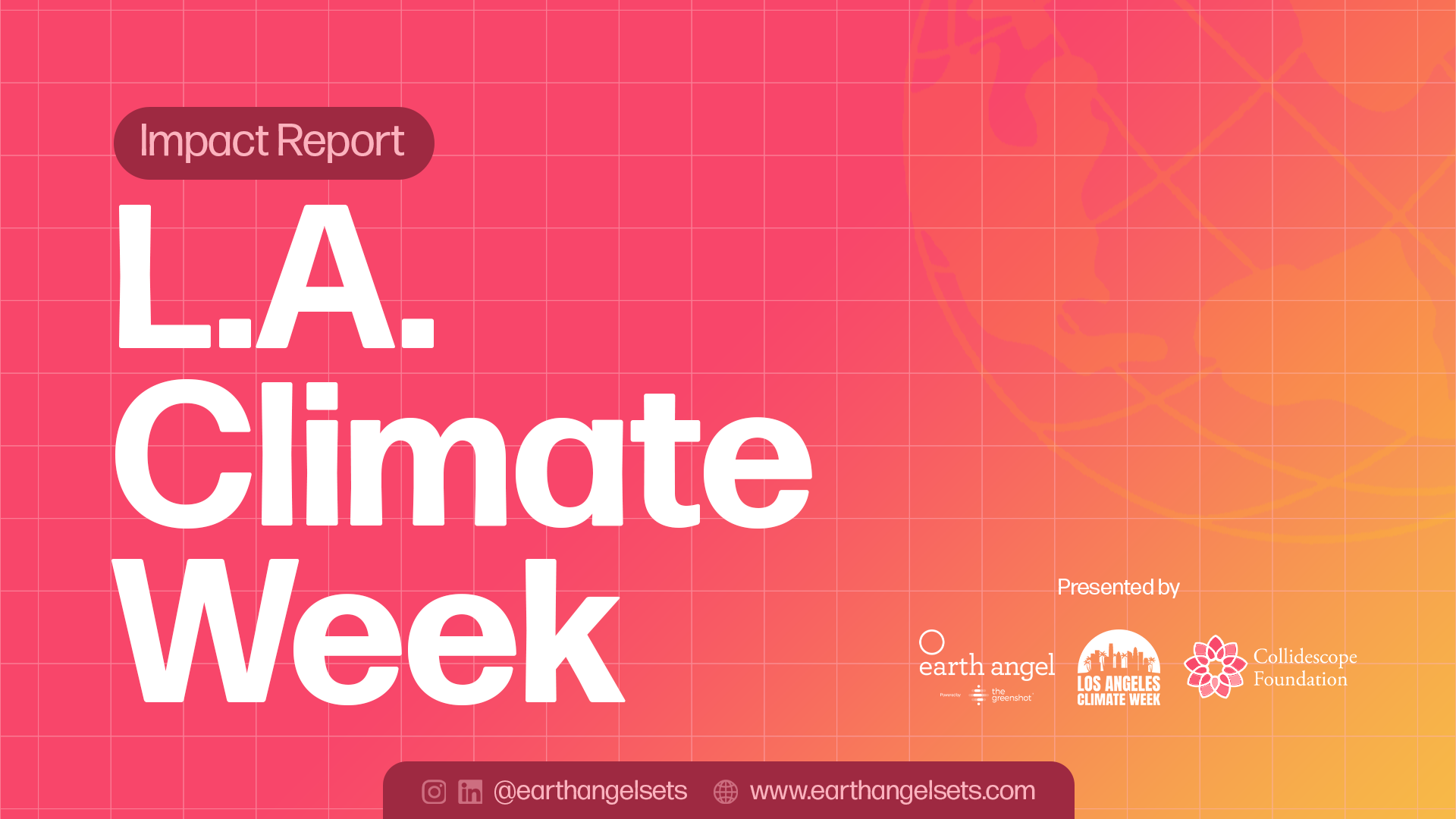Impact Report: LA Climate Week
Introduction
Last year, Earth Angel was proud to act as the Official Sustainability Partner of the inaugural Los Angeles Climate Week. Led by Eco Supervisor Bronwyn Thomas, our team of specialists developed and executed the end-to-end sustainability strategy for the city-wide event. At the end of the week, the data collected was analyzed by Aisling Power, Analytics Manager at Earth Angel, using a variety of reporting frameworks.
Together, we successfully reduced travel-related emissions by employing 100% local crew, eliminated red meat from the menu, avoided 6,364 single use plastic bottles and more — resulting in an astonishing 6.24 MT of CO2e prevented from entering the atmosphere. That’s equivalent to approximately 687 gallons of fuel (source: www.epa.gov)!
“It was such an honor to have Earth Angel on the inaugural LA Climate Week team! They helped ensure that our own events were sustainably produced along with setting standards and examples for the industry.”
— Dan Thorman
Co-Founder and Co-Executive Director, Collidescope Foundation
See the details of our findings below.
Carbon Impact
Carbon Footprint
LA Climate Week's carbon footprint was calculated using the AdGreen Carbon Calculator. The carbon footprint from this event is estimated at 0.46 metric tonnes of carbon dioxide equivalent (MTCO2e) — equivalent to approximately 50.7 gallons of fuel — the bulk of which was attributable to food consumption based on meals served at the event.
Baseline Comparison
Here’s an overview of Earth Angel's Short Form Production carbon impact per shooting day. This data includes commercials, photo shoots, and live events, and updates as we work with more productions.
The pictured data is current as of Oct. 2024 and the sample sizes for each category are listed alongside (i.e. N = 38).
Emission Reduction Results
-6.24 MTCO2e
Initiatives undertaken prevented 6.24 MT of CO2e from entering the atmosphere.
Approximately 50% of these avoided emissions come from utilizing a fully plant-based menu.
The majority of remaining avoided emissions resulted from employing two electric generators to supply all the power for the event.
Carbon Equivalencies
We use the EPA's Greenhouse Gas Equivalencies Calculator to illustrate what 6.24 MTCO2e represents in terms of other units of measurement.
In this instance, emitting this amount of carbon dioxide is equivalent to:
15,999 miles
driven an average gasoline-powered passenger vehicle
687 gallons
of fuel consumed
7.9 acres
of U.S. forest required to sequester carbon over one year
Energy & Fuel Consumption
“The energy strategy at LA Climate Week was a huge success. Not only did they utilize EVs and electric generators, they were intentional in their decision to host the event in an energy-efficient facility and provided reusables!”
— Bronwyn Thomas, Eco Supervisor
Fuel Purchases
LA Climate week utilized two EVs and two BESS* Units from Saniset, eliminating all Scope 1** emissions for the event.
* Battery Energy Storage System
** Scope 1 emissions are direct greenhouse (GHG) emissions that occur from sources that are controlled or owned by an organization (e.g., emissions associated with fuel combustion in boilers, furnaces, vehicles). (EPA.gov)
Utility Use
Earth Angel received exact totals from the studio the amount of electricity consumed (Scope 2)* for the run of show.
The carbon impact from this data was estimated to be 0.13 MTCO2e based on local grid emission factors.
663 kWh
Estimated Electricity Usage (kWh) in studio, which is equivalent to 0.13 MTCO2e of emissions.
*Scope 2 Emissions: Scope 2 emissions are indirect GHG emissions associated with the purchase of electricity, steam, heat, or cooling. (EPA.gov)
Zero Waste
Waste Generated by Stream
The bar chart below illustrates the types of waste streams generated by weight — In this case: mixed compostables, mixed recycling, food donations, and landfill.
The pie chart illustrates the proportion of each waste stream to the overall amount of waste generated. The majority of waste generated went to mixed recycling and composting (75%).
With the addition of food donations, total diversion approached 79%.
Diversion Rate Ranking
This graph depicts how the event diversion rate compares to:
The EPA diversion rate average (i.e. what the diversion rate would be without sustainability efforts, which ranges from 0 - 32%).
Earth Angel’s overall average Short Form Production diversion rate average (sample size of 62 SFPs*).
Earth Angel's event diversion rate average (sample size of 18 commercials*).
Sustainability Impact
LA Climate Week created multiple positive impacts through taking the following actions:
All crew was local, eliminating travel-related emissions.
Crew travel is often the largest carbon contributor for short form productions, including events.
Two EVs and two electric generators used, eliminating all scope 1 emissions.
This avoided a total of 2.7 MTCO2e — approximately 297 gallons of fuel.
All food vendors were vegan, greatly reducing the food emissions.
This avoided approximately 3.25 MTCO2e — approximately 358 gallons of fuel.
Majority compostable service-ware used.
100% reduction in single use water bottles through reusable cups and filtered tap water.
This avoided approximately 6,364 single use plastic bottles.
That’s a wrap!
“LA Climate Week’s team was incredibly passionate about their mission, which is why this event was such a huge success. I have no doubt their team will continue to use sustainable practices as their guide as they grow in the years to come.”
— Bronwyn Thomas, Eco Supervisor
Earth Angel would like to acknowledge the hard work and effort put in by all the LA Climate Week team and behind the scenes crew that helped produce this event sustainably.
Big thank you to our Eco Reps:
Kate Peters, Alex Tolerico, Stevie Gray, and Chelsea Ramirez
More like this:
Contact Us
Worked with us before and know exactly what you’re looking for?
New to working with us and not sure exactly what you need?
For other sales-related inquiries, please email sales@earthangelsets.com.















